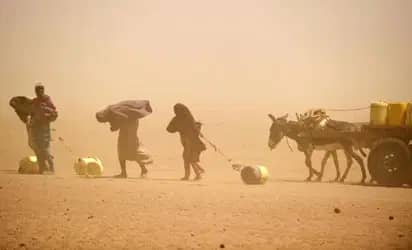Rising temperatures and heat waves are not only threatening our environment but also disrupting the learning environments of millions of children worldwide.
A report by Global Partnership for Education, GPE, in conjunction with the World Bank has said.
The report is titled: Too hot to learn: The impact of climate change on education.

It went further to state that by 2050 almost every child in the world – nearly 2.2 billion children – will be exposed to frequent heat waves.
Therefore, it called for investing in climate-resilient schools and education systems, saying it is essential to ensure that every child realises their right to learn in a safe and conducive learning environment.
Climate change has psychologically and physically affected our learning. It is also making the school environment unhealthier day by day, Prakash,18-year-old student in Nepal, said.
Heat waves, exacerbated by climate change, are becoming more frequent and intense.
This poses a significant educational challenge, particularly in regions with inadequate infrastructure and resources.
Schools in many parts of the world, especially in low- and middle-income countries, lack proper ventilation, cooling systems, and access to safe drinking water.
This can make classrooms unbearable and potentially hazardous during extreme heat.
When temperatures soar, governments often face the dilemma of keeping schools open or closing them temporarily – disrupting children’s continuity of learning.
It added that in May 2024, heatwaves in Pakistan forced schools to close, leaving 26 million, or more than half of the country’s school-age children, out of the classroom.
In April, South Sudan closed its schools for 2.2 million students when temperatures soared to 45 degrees Celsius (113 degrees Fahrenheit).
Thousands of schools in Bangladesh, India and the Philippines have also had to close due to extreme heat.
In recent years, these heat waves have arrived earlier, become more severe and lasted longer, leaving schools unprepared to cope.
In humanitarian contexts, the impact of heat waves on education becomes even more urgent. Vulnerable communities grapple with multiple challenges of climate change, conflict and forced displacement, making access to quality education a critical lifeline for children.
Even if students continue attending classes during heat waves, their education will likely suffer.
High air temperatures and lower hydration levels are known to affect children’s ability to concentrate, retain, and process information, impacting overall school achievements.
In South Asia, 78 per cent of students surveyed said that their studies had been affected by climate change. Most cited either an inability to concentrate during heat waves, damage to their school buildings, or disruptions to their journey to school.
As heat waves become more frequent and last longer, the need for urgent action grows stronger.
Recent data suggest that action is urgently needed to make education systems climate-resilient: in 2023, a UNICEF survey found that among 40 countries assessed as having high or extremely high risk of children’s exposure and vulnerability to the impacts of climate change, only a third of such countries reported concrete government action on greening education.
Recognising the profound implications of climate change on education, governments, with support from UNICEF, the Global Partnership for Education and other actors, are working to strengthen the climate resilience of children, education personnel, schools, and education systems.
Great attention on preparedness efforts can protect marginalized populations, especially children.
This includes improving school infrastructure to ensure that educational facilities can withstand extreme weather conditions and disasters, including structural improvements such as better ventilation and cooling systems.
Efforts are also underway to upskill teachers on climate-resilient practices and emergency preparedness, empowering them to support students and communities during crises.
Additionally, governments are implementing policy reforms and investments that integrate climate resilience into education sector planning and decision-making.
These initiatives promote green skills and engage children and young people in climate-smart solutions and local climate advocacy.
These efforts are urgently needed, as UNICEF survey data show that a mere 8 percent of countries report providing climate education to at least 70 percent of children and offering professional development opportunities to teachers in climate education.









